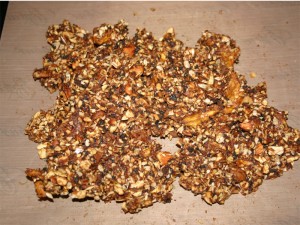A few days ago my wife and I attended an all day meditation class. We were asked to bring something to share during the lunch break. I knew that I wouldn’t have the time just before class to prepare anything, so I kind of put the idea of bringing something out of my mind and tried to neglect it. My wife didn’t. She suggested that we bring some granola that I’d make a couple days earlier. Her thinking was that it was done, raw, I could make more AND it tasted great. I agreed and didn’t think much more about it.
During the lunch, I was glad to see that multiple people picked it up and gave it a try. Turns out that the bowl was emptied quite quickly. A number of people sought out the chief (me) in order to figure out what was in it and they politely share their application. It’s not often that I go somewhere with my wife and not see everyone praising her over one of her fabulous concoctions!
Originally, I mentioned for the folks to just connect to this blog and search for granola. The search in the upper right hand side works really well at finding keywords and the article would simple come up. If you go and do that, you’ll find that the old granola article that I posted referenced a recipe that is no longer on the web! Dang. The old site that has been down for a while now and the folks that ran it seemed to have disappeared somewhere east of the rockies. Looks like the original recipe is gone for good.
So, from memory, here it is. Note that I make it different each time so the ratios really depend on what you have available to you when you start mixing. The one key ingredient, ground cinnamon powder, you’ve got to have that.
- 1-2 cups raw hulled sunflower seeds soaked overnight
- 1 (or more) cup raw hulled pumpkin seeds soaked overnight
- 1 cup raisins soaked overnight
- ½ cup dried apricots soaked overnight
- 1 cup almonds soaked overnight
- 1 cup pecans soaked overnight
- 2 apples
- 1 heaping spoon full ground cinnamon powder
- ½ ripe pineapple (optional)
- ¼ to ½ cup maple syrup
You’ll also need a food processor and dehydrator.
Step 1, soak the nuts and seeds! Give them time to rehydrate and start growing. With the nuts, soak for 6-8 hours and then rinse them off good. With the seeds, do the same but also let them grow for a while. Say, overnight. Make sure to rinse them good before using them for the granola. Also, soak the raisins and apricots. Yet, with the raisins and apricots, rinse them a few times before soaking them. You want to get any residue off the fruit before letting it hydrate. When we use this fruit, we’re also going to use the water that it’s soaking in. When you soak fruit, the water picks up a lot of the sugar. Since we’ll be removing the water in the dehydrator, there is no need to drain out that extra sugar!
As you can see in the above picture, I’ve run each main ingredient through the food processor. I pulsed each one and then poured it into the bowl. Each time, I made sure that there was some texture left with the particular ingredient. I don’t really like large chunks, so if you were to look at the almonds and pecans, you’d see that the biggest pieces are about ¼ to ½ the nut.
When it came to the apples, I cored them and ran them through the grader option. With the raisins and apricots, I mixed it until it was paste. The fruit is the glue that holds everything together.
When I added the pineapple this time, I wanted that chewy fruity feel so I cut it down to pie shaped pieces knowing that the dehydrator will take it down the rest of the way.
Step 2, mix it all together. Get everything evenly distributed and then add a large heaping spoon full of ground cinnamon powder and the maple syrup. Mix it more until the herb is spread evenly.
I like sheets of granola, thus I spread this large bowl out on four dehydrator sheets. Notice that I pressed it down to the width of the pineapple chunks.
Step 3, dehydrate overnight or maybe a bit longer.
You can peel it off and eat at any point, I like it when it’s still bendable but breaks apart if bent too far. This is usually 24 hours at 115 degrees.
When it’s done, you can’t tell there was ever any apple added. You’ll see the dark raisin and nut pieces, but everything else just kind of blends in like cereal.
Oh, most people think of this as candy! With all the fruit, it’s really sweet. I treat it like candy too. In a way, it’s like peanut brittle. The last picture doesn’t really show it, but in order to store it in an airtight zip lock bag, I fold the sheets over and over again until the pieces are 2-3 inches in size. Thus, each time I go for a snack, I get a cookie size piece to enjoy!
Note that the real trick here is the ground cinnamon powder. It’s just not the same without it!




